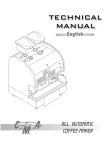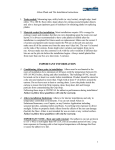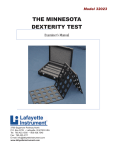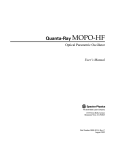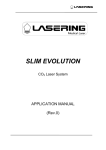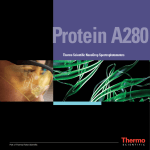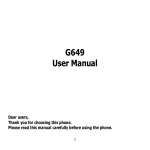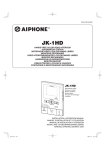Download GUIDA ALL`ABBRONZATURA-ING
Transcript
SOLARIUM GUIDE HANDBOOK FOR THE PROPER UTILIZATION OF TANNING EQUIPMENT. www.isoitalia.com INDEX 03 What is a Solarium? 04 The Solarium: all the benefits of sun on our skin. 06 There are two different kinds of tan. 08 The Melanin: a natural shield against the sun. 10 Why does the skin get tanned? 12 The importance of Ultra Violet Rays (UVB) for our health. WHAT IS A SOLARIUM? The word Solarium means “a place in the sun.” In all cultures, sunbathing is an integral part of beauty and health treatments of the body. Beaches, terraces and gardens are a traditional places for sun exposure. Todays tanning equipment emit a UV calibrated radiation, which can be modulated on specific characteristics of the user’s skin. Getting tanned can make one appear beautiful and fell great, but it has to be done by following some simple rules if one wants to make the best of it's benefits safely. 14 What is the composition of Sun rays? 16 Distribution of solar rays spectrum arriving to earth. 18 The Light and the Body’s rhythm. 20 Extreme ultraviolet radiation Exposure to Sun rays stimulates the production of melanin within the skin and can have beneficial effects on ones health. Some of the beneficial effects of exposure to sunlight are: 22 Ultraviolet rays and aging. 24 For a proper utilization of 1 Supports Vitamin D synthesis which is absolutely necessary to promote Calcium production and its fixing inside the bones. 26 Tanning starts from the table. 2 Increases the thickness of the horny layer of epidermis making it more resistant. 28 UV ray properties. 3 Has beneficial effects on some kinds of skin diseases such as psoriasis atopic and seborrhoeic, dermatitis, and acne. problem. tanning equipment. 29 Useful advice. 30 Tanning equipment. 2 THE POWER OF TANNING AND HEALTH 4 Infuses a feeling of well being since it supports the activation of the neuroendocrine system and hypothalamus axis, the hypophysis - thyroid - adrenal gland with the hormone secretion which positively effects our moods to stave off depression. 3 THE SOLARIUM: ALL THE BENEFITS OF SUN FOR YOUR HEALTH The Solarium light is made of tanning ultraviolet rays A-type, and of a small quantity of ultraviolet rays B type, in dermatologically safe ratio. In order to let people have a safe tan without the risk of getting burned, it is absolutely necessary to regulate the exposure times according to the different skin characteristics of each user. This is called the users cutaneus phototype. Tanning indoors makes you happier and more constructive, consequently increasing your self-confidence, strength and …glamour! Solariums tan through the emission of artificial light; they have been designed to mitigate the diseases caused by the lack of sun light. The solarium light is just an artificial sun light; it imitates the natural sun light and, just like the sun light, is made of visible rays, infra red rays and ultraviolet rays. But, while the sun light changes its composition and intensity according to the hour of the day, the season, solarium light is always constant and not conditioned by these factors. 4 5 THERE ARE TWO DIFFERENT KINDS OF TANNING SUNTAN The word “tanning” means that the skin has been tanned and has reached a dark color. The skin becomes tanned thanks to the melanin action which acts like a filter protecting the cells and DNA from being deeply penetrated excessively by ultra violet rays. In order to have a nice tan it is necessary to start with low radiation (short exposure times) and inflammation (sun burn). SUNBURN “Sunburn” is a skin inflammation due to an overexposure to ultraviolet rays (especially type B). Tanners with fair skin color (photo type I and II) and/or thin horny layer can have a hard time protecting themselves from UV rays. As a result, when they exceed their exposure limits trying to get tanned more quickly, their skin becomes inflamed and insisting burned. recovered, some dark spots come out on the burned skin, called a solar lentigo. They will last for an infinite period, as a memory of the suffered damage. 6 PROTECT YOU SKIN • The color of your skin and the horny layer thickness are very important factors for the protection of skin against the sun. • Indoor tanning causes a constant Melanin production which helps to increase the skins thickness consequently increasing its resistance. • Tanned skin is more protected from UV rays than non-tanned skin. • Indoor tanning makes skin less subject to sunburns, but it does not exempt it from several photo protective behaviors such as using UV filters and gradual exposure. 7 MELANIN: A NATURAL SHIELD AGAINST THE SUN The skin has its own system to protect from the UV rays. When the skin is stimulated by UV rays, it produces melanin and gets dark. Melanin is a natural shield against sunlight. Melanin absorbs UV rays energy and turns it into heat. UV rays and keratin production then increase. Keratin is the main constituent of the skin’s horny layer and has an important protective function. UV exposure, especially to UV B rays , can increase the production of Keratin thereby thickening the skins horny layer. The Skins horny layer thickening then acts as a filter against UV rays, reducing their penetration into the different layers of the epidermis and protecting the deepest skin cells from possible damage. 8 By combining Melanin production and an increase in thickness of Keratin, protection against dangerous sunlight increases by more than ten times. The possibility of getting tanned depends on the skin’s type The level of tanning, or pigment formation, depends on the tanners skin type. There are 4 different skin types. skin type quality and characteristics of skin: 1 VERY FAIR COMPLEXION AND PARTICULARLY SUBJECT TO SUNBURNS: When exposed to sun it gets red and gets burned quite often. Dark spots and /or freckles easily come out. It does not get tanned even if exposed to the sun for a long time (short production of melanin). 2 FAIR COMPLEXION AND SUBJECT TO SUNBURNS: when exposed to the sun it gets red and sometimes even gets burned but after that it can get slightly tanned. 3 MEDIUM COLOR COMPLEXION AND LESS SUBJECT TO SUNBURNS: when exposed to the sun it gets slightly red and gradually reaches a e golden/dark complexion. 4 DARK COMPLEXION , NEVER GETS BURNED: when exposed to the sun it gets dark very quickly, never gets burned and keeps its bronze color for a long time. People with fair complexion (photo types I and II),have a short production of Melanin and therefore a low protection from UV rays. For these reasons such people should be more careful when exposing to the sun and/or to the solarium. There also are some people that no matter what the photo type is, develop some kind of hyper sensibility towards UV rays. It shows up with the appearance of irritating photo-dermatitis on the skin (such as solar Urticaria, polymorphous sun rash etc.).In those cases we suggest you to avoid any exposure to the sunlight and to the solarium. 9 WHY DOES THE SKIN GET TANNED? Distribution of Melanin starting from the originating cell (melanocyte) to the surrounding keratinocytes TRASPORTATION OF MELANIN TO THE KERATIN SITE. PRODUCTION OF PIGMENT IN THE PRESENCE OF UVB. 10 THE ACTION OF UVB RAYS IN THE EX NOVO PRODUCTION OF MELANIN. THE ACTION OF UVB RAYS IN THE EX NOVO PRODUCTION OF MELANIN ACTION OF THE UVA RAY IN THE CUTANEOUS PIGMENTATION The Melanocytes are cells located in the basal layer of the epidermis that stimulated by the action of UVN rays, begin to produce (starting from the tyrosin) a protective pigment called melanin. The Melanin as you can see in the picture—through a small, tubular cell organelle goes through the close keratinocyte and gather all around the cell nucleus to protect the DNA. The photo oxidation is a process - which is only possible thanks to the action of UVA rays - – with the contribution of the oxygen transported by the blood. Thanks to the photo oxidation, the melanin pigment produced by the Keratinocyte gets the characteristic brown colour of tan. 11 THE IMPORTANCE OF UV RAYS (UVB) FOR YOUR HEALTH THE UVB RAYS PRODUCE THE VITAMIN D3 The UVB radiation encourages the vitamin D synthesis turning the provitamin lodged in the skin into vitamin D3 which then turns into the active state , necessary for the living organism. During the Winter time , being the exposure to UV rays less than what usually is, the production of vitamin D may might be reduced. Vitamin D consumption is very limited with the diet: some kinds of food (such as cod-liver oil), contain considerable quantities of Vitamin D, therefore the main source of such vitamin comes from the UVB exposure. VITAMIN D3 INCREASES THE ABSORPTION OF CALCIUM Vitamin D3 increases the absorption of calcium which is in the food we eat and therefore it is necessary for the bony structure development. BONE’S DISORDERS AND FRAGILITY DUE TO A LACK OF CALCIUM There is a lack of calcium ion, all the stocks hold by the bones are used to integrate necessary quantity for the vital activity with the risk that bones become brittler and brittler and more and more subject to spontaneous fractures (such as osteoporosis). UVB RAYS, THROUGH VITAMIN D, IMPROVE THE CELL METABOLISM The increase of the synthesis of vitamin D, important for the bony metabolism, is able to also regulate the proliferation and the cells differentiation, the apoptosis and the angiogenesis. 12 It has been in fact shown that low levels of vitamin D are responsible not only for bony illnesses, but also for muscular weakening, of some auto immune diseases (ex. the multiple sclerosis) or endocrine (iper parathyroidism). With the UVB rays the possibility of getting a cold decreases In fact in Europe it has been made an experiment on 3.500 children, who have been given a great dose of UVB in autumn and winter, cases of colds have enormously decreased (66% ) in comparison to the previous year, even with many flue cases all around. Besides, because of the UVBs, the immune specific cells of the body and the white globules have increased of 50%. UVB RAYS INCREASE THE MOTOR CAPABILITY UVB RAYS also produce muscular strength increase ,in fact Vitamin D3 promotes the calcium absorption with the consequent increase of the synapses formation: the capability of nerves transmission grows as well as the glycogen metabolism and the muscles contraction strength. UVB RAYS RADIATION INCREASES THE BLOOD’S ABILITY OF CARRYING OXYGEN UVB rays increase the blood’s ability of carrying oxygen stimulating the production of haemoglobin. and red globulin. A Frankfurt University’s survey confirmed that with the UVB rays exposure there is an increase of oxygen quantity availability. THE ROLE OF UVB RAYS The UVB rays radiation helps to get toxins we have in our blood out of our system by separating the organic molecules. It also improves the resolution of alcohol. 13 WHAT ARE THE SOLAR RAYS MADE OF? The solar rays are made of a fixed quantity of energy that runs in the space at a speed of 300.000 km/second, in the shape of small waves. the amplitude between two peaks or subsidence of a wave ( spectrum amplitude) is called “ wave length”. Every kind of ray has its own wave length. As the wave length gets shorter the energy carried by the ray increases. 14 100 290 320 ultraviolet rays 400 500 visible The fraction corresponding to the red light has a long wave length, therefore it is called long wave light , it also has not so much energy. The violet light fraction on the contrary has a very short wave length, it is then called short wave light. It also has a great energy. 760 1.400 3.000 IRB IRB IRA UVB UVC Relation between the energy of the solar radiation and electromagnetic waves. UVA Solar rays are made of sequential rays, ,as you can see in the picture.. The invisible light , going through a prism, parts into the 7 iris colour. Right after the 2 limits of the invisible light’s field there is the infrared (IR), - further on the red , the ultraviolet (UV) and violet. 10.000 nm infrared The unit of measurement of the wave length is the nm ( nanometre : 0,000,000,001 meter). 15 DISTRIBUTION OF THE SOLAR RAYS SPECTRUM THAT REACH THE EARTH rays category IRC IRB IRA IRC INFRAROSSI IRB IRA RED ORANGE RAGGI YELLOW VISIBILI GREEN BLUE VIOLET UVA UVA UVB ULTRAVIOLETTI UVB UVC wave length 10.000-3.000 3.000-1.400 1.400-760 760-627 627-589 589-566 566-495 495-436 436-400 400-320 320-290 % reaching the earth nearly 42 % Characteristics of rays: INFRARED WARM VISIBLES RAYS BRIGHTNESS ULTRAVIOLET nearly 52% A nearly 5,5% nearly 0,5% • The short wave UVB ( 290 – 280 nm) and UVC (280 – 100 nm) never reach the earth since they are absorbed by the components of the atmosphere , mainly by the ozone, but also by the water vapour, oxygen and carbon dioxide. B • The light arriving to the earth varies depending on the latitude, season, atmospheric condition , time, terrestrial condition , altitude and environment. CHARACTERISTICS OF DIFFERENT RADIATIONS Every single radiation has its own characteristic. The light we see comes from the visible fraction. The infra red fraction warms. The Ultraviolet light has a deep influence on the physiology of animals and human being. 16 C • affect the cell metabolism. • oxidize the melanin produced by the UVB and make the skin tanned • stimulate the production of vitamin D3 • Encourage the production of Melanin stimulating the melanocytes • Increase the keratin of the horny layer • affect the production and secretion of several different hormones • have a strong action of sterilization on the microorganisms, but they are absorbed by the ozone in the upper part of the terrestrial atmosphere and consequently do not reach the earth 17 THE LIGHT AND THE “CORPOREAL RHYTHM” The “body’s rhythm ” , in other words the regularity of different visceral functions necessary for living. ( cardiac, throw:, blood flow, digestion , elimination of scum etc. etc. ) is under involuntary control of the independent nerves system , divided by sympathetic and parasympathetic systems. The two different systems produce oppiste effects on the organism. The sympathetic system “activates” the functions while the parasympathetic one “disactivates” them. The sun controls the independent nerves The rhythm of the sun, its power and the combination its light spectrum affect the corporeal rhythm, the production of hormones and much, much more. • It seems that the exposure to the light cuts down the hematic levels of Melatonin while it is increased the effectiveness of serotonin and some other neurotransmitters which actively contribute to the improvement of mood’s tone reducing the depression and improving the sleeping/ waking rhythm (absolutely necessary; for the psychophysical wellbeing of the organism. • if we keep on exposing ourselves to the sun in the morning or in the evening, for about 30 minutes , we will have a positive effect , antidepressant. • A strong light can also help to compensate for the jet –lag , re-establishing the circadian rhythms changed by the time zone. The radiation penetrating through eyes are turned into electric impulses, transmitted trough the optic nerve to the brain. When the impulses reach the hypothalamus we have an increase of serotonin, a neurotransmitter used for controlling the mood’s tone while at the epiphysis level it is inhibited the production of melatonin, an hormone sensitive to the light- dark cycle. 18 19 A CORRECT ULTRAVIOLET RADIATION A correct quantity of Ultraviolet rays is useful for the physiologic activity but, if excessive, it has a negative effect on skin and eyes. An excessive radiation to ultraviolet rays causes sunburns The sunburn of the skin – characterize by reddening, edema, itching, pain – show an excessive exposure to the ultraviolet radiation , it happens when we exceed the Minimal Eritema Dose limit (MED) - minimum quantity of ultraviolet rays able to cause a minimum reddening, “slightly remarkable”, on the skin. Such limit may vary from subject to subject, depending on the photo type. When tanning is combined with sunburns, it can increase the risk of skin’s cancer Skin’s cells have great defence possibility against any damage that may be caused by an excessive exposure to ultraviolet rays. In fact the skin’s cells that accidentally get burned can recover from the damage in two different ways: 1) running into apoptosys (which means dying) – it shows up with the exfoliation. (in everyday language “peeling”); 2) carrying out a complex sequence of enzymatic mechanisms able to fix any possible damage to the DNA caused by the sunburn. Therefore the skin normally recover without any after-effects. If the skin got sunburnt it keeps on running the risk of getting too much quantity of ultraviolet rays incurring many times sunburns. For these reasons its capacity to recover from the DNA damage becomes insufficient consequently increasing the skin’s cancer risk. 20 21 ULTRAVIOLET RAYS AND AGEING UVA RAYS , easily crossing the horny layer of skin ,can reach the basal layer and lower derma. That it why , when we lay in the sun for too long we do not only risk such cells DNA damage but also a damage to elastic and collagen fibres which form the derma and give muscle tone , elasticity and support to the skin. This determines the appearance of wrinkles , owing to an increase of skin’s ageing process speed. T H E R E L AT I O N S H I P BETWEEN ULTRAVIOLET RAYS AND WRINKLES Prolonged exposures – or with high intensity –to ultraviolet rays make the skin old. The skin’s ageing shows itself with the appearance of wrinkles and solar lentigo. After each exposure it is recommended to utilize skin’s moisturizers. LET’S PROTECT OUR EYES FROM THE ULTRAVIOLET RAYS Exposing ourselves to an excessive quantity of UVA rays, we can incur crystal lattice damages, loss of elasticity, yellow-brown coloration), with consequent formation of cateratta. UVB rays in their turn can cause damages such as the cornea inflammation (keratitis) or conjunctiva (conjunctivitis). Therefore it is necessary ,during the tanning session, to always put protective eyewear on :simply keeping your eyes closed is not enough to completely eliminate these kind of risks. 22 SOLAR RADIATION EFFECTS (ACCORDING TO GRITER) POSITIVE EFFECTS (UP TO 1MED) • photosynthesis , necessary for life. • hormonal production control • vitamin D3 production • strong skeleton development • rickets prevention • sterilization of microorganisms. • heating • energy increase • treatment of skin and depressive diseases. • fixing of Melanin • improvement in skin’s defence with the increase of keratin. NEGATIVE EFFECTS (MORE THAN 1MED) • reddening • skin’s ageing • Photo allergic and/or phototoxic reactions. • Human tissues deactivation • skin’s cancer risk • eyes damage. MED: Minimum Erythemal Dose 23 FOR A PROPER UTILIZATION OF A TANNING EQUIPMENT Do not use the solarium if: • you have difficulties in producing melanin , therefore skin always gets red (photo type I and II) • you are less than 18 years old • you are pregnant • your skin is red or inflamed • you have many naevus • you have cuts or skin’s diseases (such as dermatitis, skin’s cancer) • you suffer from photo dermatitis (solar urticaria, solar polymorphous rash ) • you had X-rays less than 4 weeks ago. • you have tattoos (colors utilized for tattoos can turn into toxic substances.) • you took drugs that can increase the sensitivity to sun. (some kind of antibiotics. and anti-inflammatory ) : should this be the case you need to ask your doctor to find out if the drug can cause hypersensitivity to UVA rays. The tanning salon should hang on the wall a special list of any photosensitizing substances. Ask a doctor if you are pregnant. It is recommend not to use the solarium if you are having Derma-Aesthetic treatments and/or Laser Epilating Treatments. BEFORE GETTING INTO THE SOLARIUM: Take off your make up and carefully wash the part of skin where you eventually put the perfume on. Some kind of cosmetics hold substances that increase the sensitivity to the sun ( for ex. bergamot oil ,they can also chemically change under the action of uv rays and then cause toxic or allergic photo dermatitis ). Keep off any kind of food that can increase the sensitivity to ultraviolet rays. Keep off citrus fruits (oranges, tangerines), celery, figs, since they hold substances which increase the sensitivity to the sun . Before starting the tanning session do not and/or rub such food on the skin. Solarium session times: They may vary depending on the skin type and on the solarium characteristics, it is strongly recommended to refer to the salon manager or the solarium user’s manual where the manufacturer should insert a special exposure chart correlated to the user’s photo type. skin type quality and characteristics of skin 1 2 3 VERY WHITE AND DELICATE 4 COLORED / ALWAYS OK. WHITE AND A LITTLE DELICATE WITH SOME COLOR AND NOT DELICATE For an even tan you should avoid any fixed position or static posture it is suggested to move your body’s position so that the radiation reception angle is not always the same, each part of the body is sufficiently supplied with blood (good blood circulation) and the exposure times are evenly distributed on the whole body. Tanning could turn out to be not perfectly even on people with blood’s circulation problems ( emphasized by quite static or unsuitable postures), since the oxygen carried by the blood has a substantial role in the melanin oxidation’s process. 24 * Ask the tanning salon manager. 25 TANNING BEGINS WHEN ... YOU SIT DOWN TO EAT! IN ORDER TO GET THE BEST EFFECTS FOR THE TANNING SESSIONS IT IS IMPORTANT TO FOLLOW A SPECIAL DIET WHICH CONSIDERS SOME SCIENTIFIC ACQUISITIONS. FOR EXAMPLE... It is demonstrated that to improve the moisturizing and elasticity of tissues and to protect them from side effects of free radicals (responsible for the skin’s ageing processes) it is fundamental the supply of some kind vitamins. • VITAMIN H, acts on the cells renovation, it can be found in the soy, in eggs and in brewer's yeast. • VITAMIN E, antioxidant. And anti free radicals, can be found in wheat germ’s oil, in pulses, in the wholemeal cereals, in the eggs; • VITAMIN C, important for the formation of collagen and elastin - it regulates the process of production of the melanin -, it can be found in kiwis, in oranges, in grapefruit and in tomato; However you should always pay attention , since if you take it in large quantity during the year, without sun, it gives to the skin a jaundiced complexion. A precautionary treatment based on the integration of the diet with Beta-carotene, vitamin C, vitamin is, allows to strengthen the protections of the organism against the oxiding action developed by the free radicals, particularly in the people with fair and sensitive skin (photo type I and II), and to improve the quality of tanning. • VITAMIN A, whose precursor, the beta-carotene, hold in fruit and in vegetables, is plentiful in yellow-orange colored vegetables (such as :carrot, apricot, melon, pumpkin, yellow peach etc.). There also are food integrators that, if added to the diet, can improve the cutaneous pigmentation. Among these, the betacarotene, which if taken before and during the solar exposure period , allows to get an intense, golden and more lasting tan, it also has an anti-inflammatory effect opposing the damage induced by the production of free radicals of the oxygen. 26 27 FURTHER UV RAYS PROPERTIES Do not undervalue the sun! Sun has a great power on life. During the sunny days there is a better mood and we feel like moving.. By the end of wintertime , wih the first lukewarm spring days , we feel like to be born again .This proves that the sun has a great influence on us. The The body’s rhythm that regulates our metabolism and the vital functions, is for instance, "circadian": it is regulated by the cycle of the sun, from the alternation day-night. The circadian rhythm also influences the production of different hormones that regulate the physiology of our body and our mood. Nevertheless people who expose themselves just a little to the solar light it is more likely to suffer from insomnia or depression, besides having a reduced production of vitamin D, essential for the health of the skeletal apparatus. UV RAYS have different effects on health The solarium is used by a lot of people in the most different structures: thermal baths, gyms, covered swimming pools, saunas, tanning salons, Spas. The cutaneous tan helps to protect from the damages of an excessive solar exposure. SOME USEFUL ADVICES... PROTECT YOUR EYES! • always remove contact lenses • use special glasses (high protection from UV) close the eyes and do not look at the light if not wearing the above mentioned glasses RESPECT THE MAXIMUM ONE DAY-QUANTITY OF IRRADIATION The sun and the solarium emit the same kind of radiation. The total exposure doesn't have to exceed the indicated quantity for your own type of skin. LET PASS AT LEAST 24 HOURS FROM ONE TREATMENT TO ANOTHER UV rays solicit the skin. Give it the time to get back to normal (at least 24 hours). BEGIN WITH SHORT SESSIONS AND GRADUALLY INCREASE THE DURATION • For a safer tan, just start with a small dose of UV keeping the recommended interval between a treatment and the other. INTERRUPT IT IF YOU SEE SOME REDNESS. If, even if you are respecting the above mentioned rules, you see redness or desquamation, it means that you need to take a brake to let the skin get back to its normal condition. The subsequent time, it will quicker get back to normal * should the inflammation be worrisome, immediately interrupt the exposure and ask your doctor. DO NOT EXPOSE YOURSELF TO IRRADIATION BEFORE GOING TO BED. • Strong lights have an exciting effect. Therefore if you take a tanning session before going to bed could cause insomnia. 28 29 TANNING EQUIPMENT The above mentioned has a great importance if we utilize tanning equipment withquality requirements prescribed by the rules.The quality of tanning equipment is fundamental: failures can have effects on the UV rays emission. Solarium manufacturers are asked to respect the European regulation(EN 60335-2-27 and subsequent ones); they must then respect the emission limits provided by the law , check the mechanical risks, electrics and electromagnetic, and attest the respect of all obligations applying a nameplate to the solarium where you can clearly read: • equipment’s kind • year of construction • power or current of absorption and cos j • voltage and net frequency• type of UV • type of service of the equipment • mark People who do not comply to this compulsory direction cannot introduce some kind of solarium on the market. An useful element to highlight the superior level of the tanning equipment to the users, besides its perfect conformity to what has been provided by the law, is the Quality Mark. The Quality Marks are not compulsory for the manufacturers but they are granted to the firm by an external institution that makes controls and encoded verifications and supervisory visits on the production site. Maintenance operations Each single tanning equipment, also a good quality one, can risk to lose its own characteristics if not properly serviced. Tanning equipment, just like any other kind of electric equipment having effects on people’s body , need to be constantly and properly serviced by qualified personnel authorized by the manufacturer. It is a fundamental condition for the proper operation of the solarium. Be sure that the solarium you are using has been manufactured following the regulations in force, has been properly serviced and has only original parts. Guarantee the respect of your tanning rules and respect your skin. Below listed you will find some Quality Marks examples: Thanks to these precious professional people and with the instructions we gave you in these pages, we are certain that your tanning sessions will give you the best results. The professionalism The European Law foresees that the technical management of the "professional" solariums is carried out by authorized personnel only who have been previously trained. Usually in Italy this professional figure matches with the beautician. Thanks to the competence and experience of the beauticians, people attending the beauty and tanning salons can be sure of getting the best from the solarium fully respecting the safety parameters with an approach to the tanning session calibrated on the specific characteristics of your own skin. Manufacturers must also give, for each marketed solarium, a users and maintenance handbook,translated into the language of the country where the equipment is going to be utilized . It must have , besides the specific recommendation, a chart with maximum exposure times provided by law, for each specific model, for each skin’s type. Some indications of the current European Regulationscan help having an idea of the minimum quality of the solarium must even if you are not a technician. • No glasses should be used to close the tanning shield in the solarium owing to their dangerousness in case of breakage .• It should not be admitted the utilization of protection grids allowing the users to touch any kind of electric components or mechanical parts in motion. • There must not be any openings or holes which allow the users to touch dangerous parts (with voltage) or mechanical mechanism.• It must never be possible to see, from any side, white light coming from the high pressure lamps.• All the electrical connections must be unapproachable for the users.• The “Red Emergency Button”, ( the button to completely and immediately stop the session whenever there is an emergency) must be easily reachable and easy to see • the users’ instruction labels must be translated into the user’s language and easy to read. • There must not be any plastic or metal parts with sharp corners or potentially sharp. • There must not be any locks allowing the users to lock himself inside the tanning room. 30 We wish you a good tan! For further information please check our web site: www.isoitalia.com 31 The Tanning lotions: Usually when we speak about tanning lotions we mean two different product categories: the ones with UV protection and the ones called “ accelerators” or “stimulators” . They basically are two different products typologies and we need to start knowing them better to better utilize them during the indoor and outdoor tanning session. How do the SPF products work: There is a specific worldwide recognized nomenclature called Sun Protecting Factor (SPF) quoting a number which refers to the protection level. The Sun Protection Factor represents the protection level of a solar filter and states the ratio between the amount of UV radiation you need to produce a just noticeable erythema on the skin where you put UV protection lotion and the necessary dose to produce the same reaction without putting UV protection lotion on. The numerical value of SPF, is given by the ratio between the time you need to get erythema on the sun protected skin and the time you need to get the same result without UV protection, as follows: SPF = MED sun protected skin/MED unprotected skin The SPF allows to determinate the protective factor of a product and consequently to choose a a protection suitable to your own phototype. Example: session duration 3 h (180 MINUTES) MED for medium phototype 12 minutes = SPF15 (180/12). Clinical surveys states that the quantity of utilized products must always be not less than 2 mg/cm2 in order to not make the effect of the product fruitless. The “Tanning Accelerators or stimulators”: The main task of these products is to help getting better tanning results by optimizing the actions connected to the stimulation and oxidation of Melanin. It happens through the integration of such components like Tyrosine and Caprylic Acid or other kinds of agents able to concentrate the tanning effect. Coloring components and self tanning products utilization is no less important ,they allow to have faster results without any contraindications. As a matter of fact the walnut husk, caramel, the riboflavin improves the keratin pigmentation; the DHA (DocasaHexanenoic Acid) on the contrary reacts creating Melanoidins. This reaction has been discovered by studying the breadmaking , living a darker aspect to the skin without acting with Melanin. Nowadays , the most advanced products also offer many components which improve the quality of the skin becoming real and actual integrators. The best lotions utilize high percentages of ALOE VERA which, as we know well, is a strong moisturizer , rich in healing and soothing properties. The plant has been used for its many health benefits since the Egyptian and old Greece times. Pantenol or Provitamin B5 are molecules which hold the moisturizing 40 times their weight, that means that 1 Pantenol molecule holds 40 molecules of water. Components like Vitamin E and Vitamin C are powerful as anti-oxidants and for their skin repair action, they fight against photo-aging . The Coenzyme Q10 is also well known as free-radicals fighter. We could also list some other components like Vitamin A which encourages the epithelial cells growth and important oils such as (Almond, Soy, pomegranate etc.) to keep skin moisturized and do never feel the dryness effect we usually feel after one day of sun exposure.. Using this kind of products does not only improves tanning but also makes your skin look better. An healthy skin for a great looking tan! Provided by: www.isoitalia.com www.itaneurope.com

















